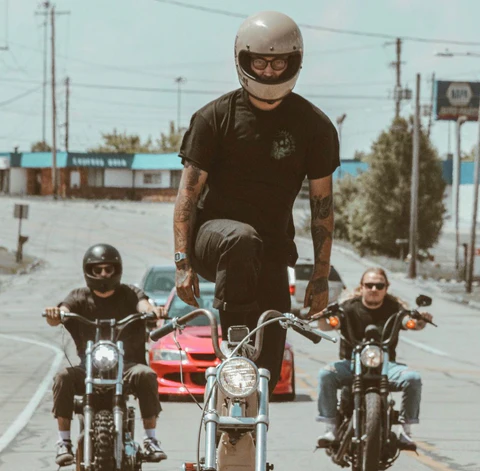ow to Choose the Right Cycle for Your Needs

In the world of cycling, there’s a unique charm and allure associated with second-hand and vintage bicycles, often referred to as “boneyard cycles.” These bikes, with their rich histories and distinct character, offer riders an opportunity to own a piece of cycling heritage. Whether you’re a cycling enthusiast, a collector, or someone looking for an affordable way to start riding, boneyard cycles can be an excellent choice. This article explores the appeal of boneyard cycles, how to choose the right one, and tips for restoration and maintenance.
The Appeal of Boneyard Cycles
Boneyard cycles, or second-hand and vintage bicycles, are prized for several reasons:
- Affordability: Purchasing a second-hand bike can be significantly cheaper than buying a new one. This makes cycling accessible to a broader audience.
- Sustainability: By opting for a used bicycle, you contribute to reducing waste and promoting recycling, supporting environmental sustainability.
- Unique Designs: Vintage bikes often feature unique designs and craftsmanship that are hard to find in modern bicycles.
- Quality Materials: Many older bicycles were built with high-quality materials and construction methods, ensuring durability and longevity.
- Historical Value: Owning a vintage bike allows you to connect with cycling history and heritage, often sparking interesting conversations and admiration.
Types of Boneyard Cycles
Understanding the different types of boneyard cycles can help you make an informed decision:
- Vintage Road Bikes: These bikes, typically from the 1960s to the 1980s, are known for their lightweight steel frames, classic drop handlebars, and narrow tires. Brands like Schwinn, Raleigh, and Peugeot are popular among collectors and enthusiasts.
- Retro Mountain Bikes: Early mountain bikes from the 1980s and 1990s offer a rugged charm with their sturdy frames, wide tires, and simple yet effective components. Brands like Specialized, GT, and Trek have iconic models from this era.
- Classic Cruisers: These bikes are characterized by their comfortable, upright riding position, wide seats, and balloon tires. They are perfect for leisurely rides and have a nostalgic appeal.
- Touring Bikes: Vintage touring bikes are designed for long-distance travel and often feature durable steel frames, multiple gears, and mounting points for racks and panniers. They are ideal for bikepacking and adventure cycling.
- BMX and Track Bikes: Older BMX and track bikes from the 1970s and 1980s are sought after for their simplicity and iconic designs. Brands like Haro, Redline, and Schwinn have legendary models in this category.
Choosing the Right Boneyard Cycle
Selecting the right boneyard cycle involves several key considerations:
- Condition: Assess the bike’s overall condition. Look for signs of rust, frame damage, and wear on components. A bike in good condition will require less work and investment to restore.
- Frame Size: Ensure the frame size matches your height and body type. An ill-fitting bike can cause discomfort and reduce the quality of your riding experience.
- Brand and Model: Research the brand and model of the bike. Some brands and models have higher value and collectability, which can influence your decision.
- Component Compatibility: Check if the bike’s components are still available in the market. Some vintage bikes may have proprietary parts that are hard to replace.
- Purpose: Consider how you intend to use the bike. Whether it’s for commuting, leisure, or collecting, ensure the bike aligns with your goals.
Tips for Restoration and Maintenance
Restoring and maintaining a boneyard cycle can be a rewarding project. Here are some tips to help you along the way:
- Cleaning: Start with a thorough cleaning. Remove dirt, grease, and rust using appropriate cleaners and tools. A clean bike is easier to inspect and work on.
- Inspection: Carefully inspect the frame for cracks, dents, and rust. Check the condition of the components, including the drivetrain, brakes, wheels, and tires.
- Replacement Parts: Source replacement parts if needed. Look for NOS (New Old Stock) parts or modern equivalents that fit your bike. Online forums, bike shops, and swap meets are good places to find parts.
- Lubrication: Apply lubricant to moving parts such as the chain, derailleurs, and bearings. This ensures smooth operation and prolongs the life of the components.
- Customization: Consider customizing the bike to suit your preferences. You can upgrade certain components, change the saddle and handlebars, or add accessories like racks and lights.
- Professional Help: If you’re not confident in your mechanical skills, seek help from a professional bike mechanic. They can provide expert advice and services for more complex repairs and restorations.
Enjoying Your Boneyard Cycle
Once your boneyard cycle is restored and ready to ride, you can enjoy the unique experience it offers. Here are some ways to make the most of your vintage or second-hand bike:
- Join Cycling Groups: Connect with other enthusiasts by joining cycling groups and clubs. Many communities have groups dedicated to vintage bikes and classic rides.
- Participate in Events: Look for cycling events and rallies that celebrate vintage bicycles. These events are great for meeting like-minded individuals and showcasing your bike.
- Explore New Routes: Use your restored bike to explore new routes and trails. The charm of riding a vintage bike adds to the adventure and enjoyment of cycling.
- Document Your Journey: Keep a record of your restoration process and cycling adventures. This can be in the form of a blog, social media posts, or a personal journal.
Conclusion
Boneyard cycles offer a unique blend of affordability, sustainability, and historical value. Whether you’re a seasoned cyclist or a newcomer to the world of bicycles, a second-hand or vintage bike can provide a rewarding experience. By carefully selecting, restoring, and maintaining your boneyard cycle, you can enjoy the charm and character of a classic ride while contributing to the preservation of cycling heritage. So, dive into the world of boneyard cycles and discover the joy of owning a piece of cycling history. Happy riding





